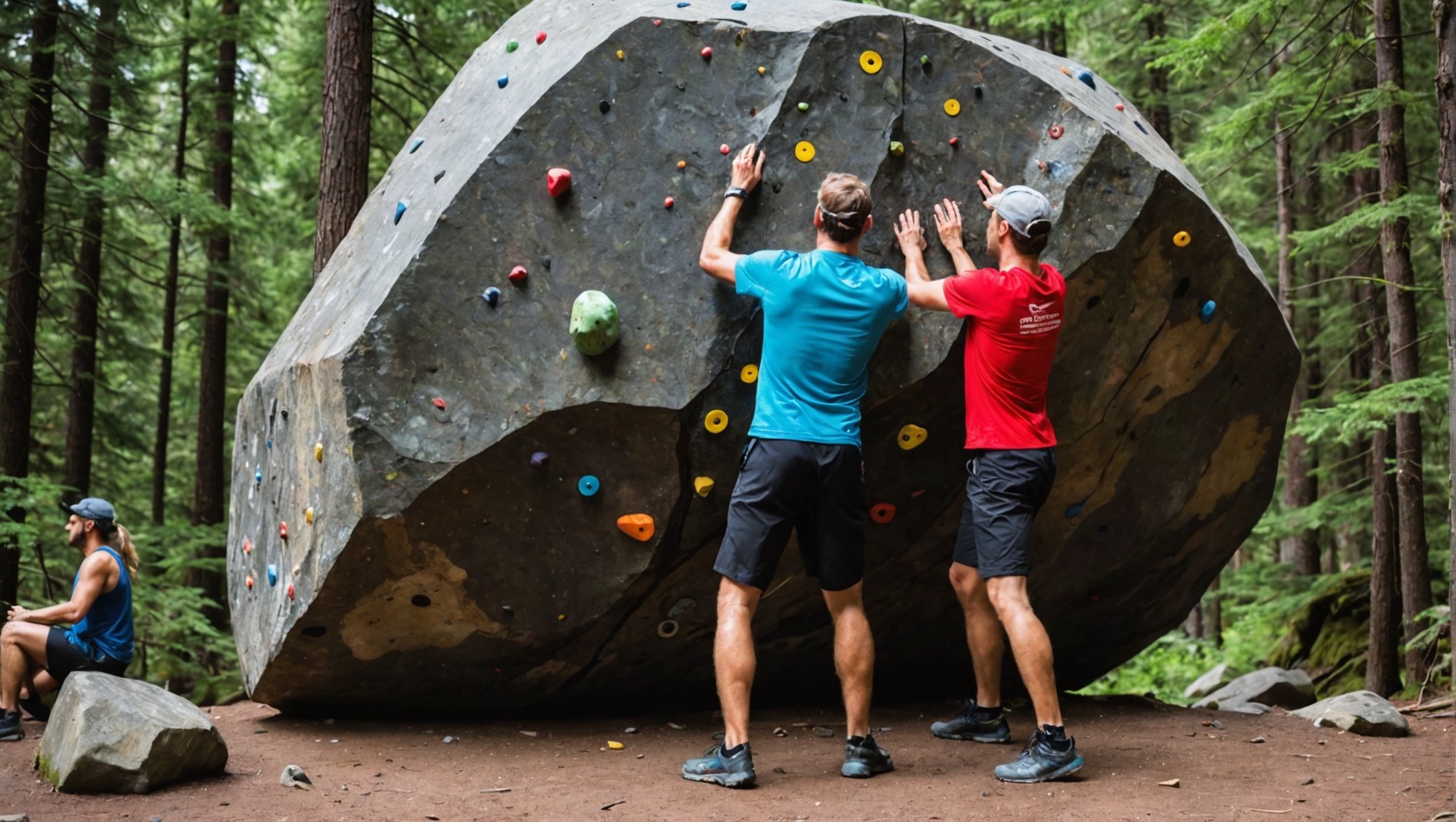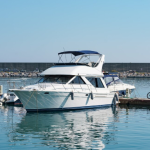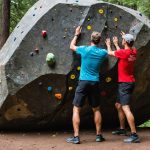Top Safety Tips for Bouldering Newbies: Essential Measures Every Beginner Should Know
Understanding the Basics of Bouldering
Before diving into the safety tips, it’s crucial to understand what bouldering is and what it entails. Bouldering is a form of rock climbing that involves ascending short, lower-level rock formations or artificial walls without the use of ropes or harnesses. This type of climbing is popular both indoors and outdoors and is an excellent way for beginners to build strength, technique, and confidence.
Preparing for Your Climb
Choosing the Right Gear
When it comes to bouldering, having the right gear can make a significant difference in your safety and performance. Here are some essential items you should have:
Also to see : Discover the Best 3 Stretching Exercises Every Curling Athlete Should Master
- Climbing Shoes: These shoes are designed to fit snugly and provide support and grip on the holds. They are a must-have for any serious climber.
- Chalk Bag: Chalk helps keep your hands dry, which is crucial for maintaining a good grip on the holds. A chalk bag is a convenient way to keep your chalk handy.
- Crash Pads: For outdoor bouldering, crash pads are the primary safety gear. They provide a cushioned landing in case you fall. For indoor climbing, the gym usually provides thick mats or crash pads.
Warming Up and Stretching
Before you start climbing, it’s essential to warm up and stretch. This helps prevent injuries and prepares your muscles for the physical demands of climbing.
- Light cardio such as jogging or jumping jacks
- Dynamic stretching like arm circles and leg swings
- Finger stretches to improve finger strength
Safety Measures to Follow
Being Aware of Your Surroundings
One of the most critical safety tips is to be aware of your surroundings. This includes knowing the position of your body relative to the climbing wall and any potential hazards.
In parallel : Boost Your Rugby Game: Essential Dietary Supplements for Enhanced Strength and Stamina
- Rope Management: Even though bouldering doesn’t involve ropes, understanding rope management can help in other forms of climbing. For example, in sport climbing, it’s crucial to know how to position your feet relative to the rope to avoid getting tangled. The “Rule of Opposites” suggests trailing the rope off your left side when heading rightward and vice versa.
- Spotting Hazards: Always check the area below you for any obstacles or hazards. For indoor climbing, ensure the mats or crash pads are properly positioned. For outdoor bouldering, look out for rocks, branches, or other objects that could cause injury.
Communicating with Your Partner
Communication is key in climbing, even in bouldering where you might not have a belayer.
- Letting Others Know: Inform others around you about your intentions and the route you plan to take. This can help prevent accidents and ensure someone is aware of your position.
- Getting Feedback: Ask for feedback from more experienced climbers. They can provide valuable insights and tips on how to improve your technique and safety.
Falling Safely
Falling is an inevitable part of climbing, and knowing how to fall safely can significantly reduce the risk of injury.
Preparing for a Fall
- Visualize the Fall: Before you start climbing, visualize how you would fall from different positions. This can help you prepare mentally and physically for the unexpected.
- Stay Relaxed: If you do fall, try to stay relaxed. Avoid stiffening up or hyperextending your limbs, as this can increase the risk of injury.
- Protect your arms, neck, and ankles
- Transfer momentum to minimize the impact
- Use your arms to cushion your fall if possible
Practical Tips for Falling
- Roll with the Fall: If you fall, try to roll with the impact. This can help distribute the force of the fall and reduce the risk of injury.
- Avoid Landing on Your Feet: While it might seem natural to land on your feet, this can sometimes lead to more severe injuries. Instead, aim to land on your buttocks or back, and then roll to absorb the impact.
Additional Safety Tips
Wearing a Helmet
Although bouldering typically doesn’t involve heights where a helmet is necessary, it’s still a good practice to wear one, especially in outdoor settings or when climbing routes that are less than 15 or 20 degrees overhanging.
- Helmet Use: A helmet can protect you from head injuries in case you fall and hit your head on the rock or other obstacles. Even experienced climbers recommend wearing a helmet for added safety.
Climbing Within Your Limits
- Know Your Limits: Don’t push yourself too hard, especially if you’re a beginner. Climbing within your limits helps minimize the risk of injury. If you’re unsure about a particular move or route, it’s better to downclimb or seek advice from a more experienced climber.
Indoor vs. Outdoor Bouldering: Safety Considerations
Indoor Bouldering
Indoor bouldering gyms offer a controlled environment with several safety measures in place.
- Thick Mats: Indoor climbing gyms usually have thick mats or crash pads that provide a safe landing in case of a fall.
- Route Marking: Routes are often marked with different colors to indicate the difficulty level, helping you choose routes that are within your skill level.
- Staff Supervision: Many gyms have staff who can provide guidance and ensure safety protocols are followed.
Outdoor Bouldering
Outdoor bouldering presents different challenges and requires additional safety measures.
- Crash Pads: As mentioned earlier, crash pads are essential for outdoor bouldering. Make sure they are placed correctly under the climbing area.
- Spotting: Having a spotter can be very helpful in outdoor bouldering. They can provide support and help you land safely if you fall.
- Weather Conditions: Always check the weather before heading out. Avoid climbing in wet or slippery conditions, as this can significantly increase the risk of falls.
Building Strength and Technique
Finger Strength
Finger strength is crucial for bouldering. Here are some tips to improve your finger strength:
- Fingerboard Training: Use a fingerboard to perform various grip exercises.
- Hangboards: Hangboards are another great tool for building finger strength.
- Campus Boarding: Campus boarding involves climbing without using your feet, which can significantly improve your finger strength.
Climbing Techniques
- Foot Placement: Proper foot placement is key to maintaining balance and stability. Practice placing your feet securely on the holds and adjusting your body position accordingly.
- Body Positioning: Keep your body close to the wall and use your legs to push yourself up rather than relying solely on your arms. This helps distribute the weight more evenly and reduces the strain on your arms.
Bouldering is a fun and challenging sport that requires attention to safety to ensure a enjoyable and injury-free experience. By following these safety tips, preparing properly, and being aware of your surroundings, you can minimize the risks associated with bouldering.
As aspz from the Reddit community aptly put it, “Avoid climbing in situations where there’s a significant risk of injury. Experienced climbers minimize injury by anticipating every potential failure beforehand, ensuring they are prepared for any surprises.”
Remember, safety is a continuous learning process, and even experienced climbers can benefit from reviewing and practicing these safety measures. Happy climbing













